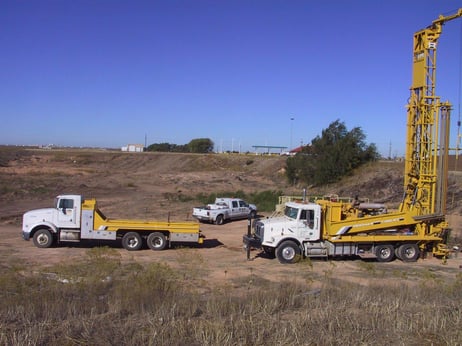 Whether you are installing soil borings for an environmental investigation or for geotechnical purposes, each one can be an avenue for contamination to reach subsurface soil and/or groundwater. Contaminating soil or groundwater can present serious safety or legal challenges. That is why it is imperative to consider potential contamination that may occur with soil borings.
Whether you are installing soil borings for an environmental investigation or for geotechnical purposes, each one can be an avenue for contamination to reach subsurface soil and/or groundwater. Contaminating soil or groundwater can present serious safety or legal challenges. That is why it is imperative to consider potential contamination that may occur with soil borings.
Soil contamination could be present before your project begins, it could potentially occur during the course of drilling or after the boring is installed. Either way, creating new areas of contamination, spreading existing contamination, or creating a pathway for contamination should always be avoided.
On your next drilling project, take special care to consider the following points regarding the potential for contamination.
What Can be Done about Existing Onsite Contamination?
It is crucial that you find out as much information as you can about current site conditions. Conduct a pre-drilling job walk with your drilling contractor, as your knowledge of site conditions will help you choose the best soil drilling methods. The following list includes examples of contamination sources or conditions:
- Historic use: Pesticides from farming may linger in soil long after farming end or petroleum hydrocarbons and solvents may have leaked into soil and groundwater from gas stations or home auto/equipment repair.
- Underground lines, tanks: Utility location services can identify underground lines for sewage to natural gas. Fuel, heating oil or waste oil in underground storage tanks may be present but not visible.
- Previous spills: Unusually discolored soil or distressed vegetation may be visible.
- Trash: Toxic or hazardous chemicals may be present in discarded containers. Some of these may be open or leaking.
- Contact Regulatory Authorities: This includes Groundwater Conservation Districts.
What Are Some Preventative Measures During Environmental Drilling?
Here are five steps that can help you avoid creating new conditions of contamination on your job site:
- Entering and exiting sites clean: Drilling equipment should arrive at the job site clean, while an onsite cleaning station can clean trucks or other equipment that must leave the job site.
- Geologic conditions: It is crucial that you understand geologic and groundwater conditions at your site.
- Good housekeeping: Properly store toxic or hazardous materials.
- Refueling or maintenance: Use drip pads or pans to avoid spills to the ground. Invest in a spill kit to quickly clean-up any leak or spill.
- Stormwater drainage: Stormwater runoff can contain vehicle-related chemicals; divert stormwater from soil boring areas or seal the top of the boring.
- After installing the boring, plug the boring according to local and state regulations as to prevent a pathway for contamination.
Talon/LPE has more than 100 years of combined professional environmental drilling experience. We are experienced in a variety of drilling conditions in Texas, Oklahoma, New Mexico, Kansas, and Colorado. The safety of our employees and the project site is the number one priority at Talon/LPE. Contact us today using the button below for your next environmental drilling project.


